98 results
German study guides for staff
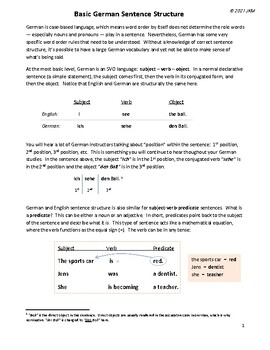
German A1 - Basic Sentence Structure (Satzbau)
This 13-page handout concentrates on elementary German sentence structure and word order for sentences/clauses having one verb. The concept of 'position' is discussed as it relates to subject, verb, object and adverbial. This lesson is a good primer on sentence structure for beginners who are comfortable with conjugating verbs in the present tense and have studied the accusative case. More advanced students may find the lesson to be a good refresher. Students will learn about typical SVO sta
Subjects:
Grades:
9th - 12th, Higher Education, Adult Education, Staff
Types:
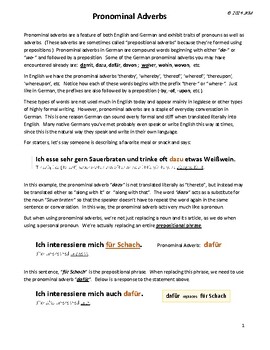
German A2 - Pronominal Adverbs (da- & wo- words)
Ten-page primer on how to use pronominal adverbs in German (damit, dafür, darauf, womit, wofür, worauf, ..., etc.). The lesson contains over 30 sample sentences in large font, color-coded for clarity. Companion English translations are provided for most of the German sample sentences. A quick summary is provided on the final page.This lesson is geared towards students at the high end of A2, and as a prerequisite, students should already be familiar with common accusative and dative prepositio
Subjects:
Grades:
10th - 12th, Higher Education, Adult Education, Staff
Types:
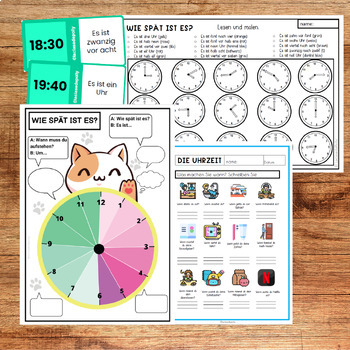
Telling the time (die Uhrzeit) German
This pack of activities are JUST PERFECT to learn how to tell the time in German! Your students will:CREATE CONVERSATIONS with the help of a big clock and cards.PLAY with a "Domino".PRACTICE with a sequence of activities.WRITE their daily routines.THIS PACK INCLUDES:An infographic to print and hang in your classroom (color and B&w).5 pages with activities and answer key."Read and Color" activity.A conversation sheet with a clock to write questions and move the clock hands.Clock labels to han
Subjects:
Grades:
7th - 12th, Higher Education, Adult Education, Staff
Types:
Also included in: German Bundle
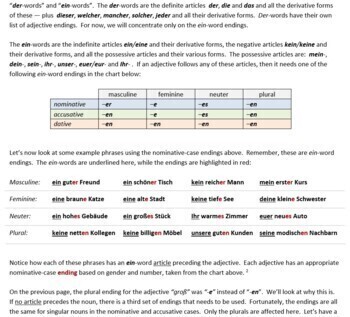
German A2 - Adjective Endings
In German, adjectives that come directly before nouns (attributive adjectives) require an ending to reflect gender, case and number. Three different sets of endings have to be learned: the so-called 'ein'-word and 'der'-word endings, plus endings for adjectives without any article preceding.This is one of the most complicated topics in A-level German, and it takes a while to master. Learning all of these endings and how to use them correctly can sometimes be discouraging for students. It sho
Subjects:
Grades:
9th - 12th, Higher Education, Adult Education, Staff

German A2 - Adjective Endings (an introduction)
This is a simple primer on adjective endings in the nominative case, geared towards students who are new to the subject as well as those who don't feel comfortable memorizing charts. The lesson starts off explaining the differences between predicate adjectives and attributive adjectives. Endings for attributive adjectives following 'ein'-articles, 'der'-articles and with no article preceding are all explained in an easy-to-read format, color-coded in large fonts. The accusative case is touche
Subjects:
Grades:
8th - 12th, Higher Education, Adult Education, Staff
Types:

German A1 - Verb Conjugation Mega-Review
This ten-page, easy to read set of printables explains the rules for most present-tense verb conjugations in German. Geared towards beginners, these review notes summarize essential conjugation rules and common exceptions and can be used as a quick test prep tool. Common types of stem-changing verbs and verbs ending in "-eln" and "-ern" are shown. The special verbs 'haben', 'sein' and 'werden' are also highlighted. The final page touches on how to conjugate separable verbs. (Modal verb conj
Subjects:
Grades:
7th - 12th, Higher Education, Adult Education, Staff
Types:
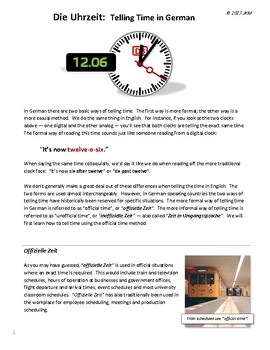
German A1 - Telling Time (Die Uhrzeit)
Complete lesson on telling time in German, using both "offizielle Zeit" (official time) and "inoffizielle Zeit" (colloquial time). Plenty of colorful graphics and clock faces help the new learner in most aspects of learning to tell time. Short quizzes and a summary of the lesson are included. As a prerequisite, students should have a grasp on how to count to 60 in German.
Subjects:
Grades:
7th - 12th, Higher Education, Adult Education, Staff
Types:

German A1 - Level 1 - Vocabulary Review and Grammar Notes
This 14-page set of study notes is divided into seven 2-page sections. Originally created as companion notes for use alongside the Schritte International A1.1 course, this set of printables is an excellent review tool for any beginning student of German. These notes can be used in tandem with an already established curriculum — or they can even be the basis for a self-directed curriculum.
Subjects:
Grades:
9th - 12th, Higher Education, Adult Education, Staff
Types:

German A2 - Two-Way Prepositions
This is an extensive 16-page lesson on two-way prepositions (Wechselpräpositionen) and how they behave in the dative and accusative cases. The material is geared primarily towards students at the A2 level wishing to increase their knowledge of the subject. Numerous example phrases and sentences are given, some color-coded. Exceptions to general tendencies and rules are discussed, along with the occasional anecdote.Although not intended as a primer on two-way prepositions, some A1 students may
Subjects:
Grades:
10th - 12th, Higher Education, Adult Education, Staff
Types:
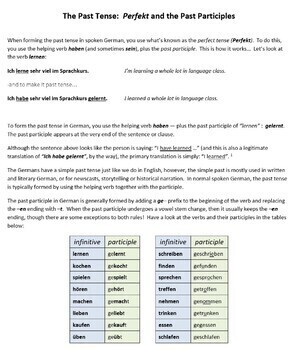
German A1 - The 'Perfekt' Tense
Three sets of study lessons on the 'Perfekt' tense are bundled together for convenient use. Part 1 is an introduction to the 'Perfekt' and how it's used. The concept of helping verb and participle is explained. Part 2 explains how to form the 'Perfekt' for separable verbs. And Part 3 contains information on forming the 'Perfekt' using the helping verb 'sein'. Additional info on participles without the "ge-" prefix is also provided.
Subjects:
Grades:
9th - 12th, Higher Education, Adult Education, Staff
Types:
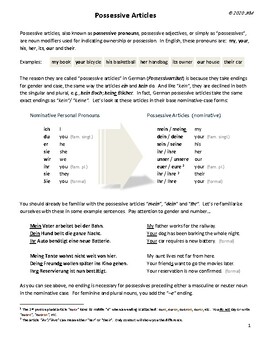
German A1 - Possessive Articles
Possessive articles (also known as 'possessive pronouns'), are noun modifiers used to indicate ownership or possession. In English, these are: 'my', 'your', 'his', 'her', 'our', etc.German possessive articles share the same endings as the article 'kein'. If you know these endings, it should be easy to use the possessives. This very thorough 8-page handout explains how to use German possessives in the nominative and accusative cases. The handout is subdivided into 4 separate sections, each e
Subjects:
Grades:
9th - 12th, Higher Education, Adult Education, Staff

German A2 - Vocabulary Review Bundle 1
21 vocabulary handouts for review and study. Each handout contains 2-3 pages of new vocabulary, sample sentences and grammar notes. Corresponds roughly with the Schritte International A2.1 course material but can be used with just about any beginning A2 course.
Subjects:
Grades:
9th - 12th, Higher Education, Adult Education, Staff
Types:
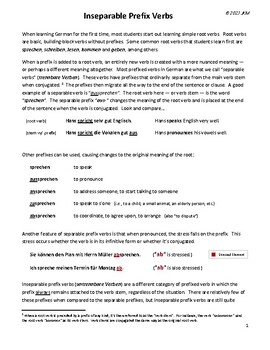
German A2 - Inseparable Prefix Verbs
An eight-page lesson on inseparable prefix verbs and how they're used in the present and 'Perfekt' tenses. The lesson starts out with a refresher on separable verbs and what makes inseparable verbs different, both in terms of syntax and also pronunciation. Roughly 40 sample sentences are provided, most with parallel English translations. Some sentences are also color-coded for clarity. A summary of the lesson is provided at the end.
Subjects:
Grades:
9th - 12th, Higher Education, Adult Education, Staff
Types:

German A1 - Intermediate Sentence Structure: 'TeKaMoLo' Rule
Second in a series on sentence structure (Satzbau), this 7-page handout describes how adverbs and prepositional phrases are ordered in a typical sentence or clause using the 'TeKaMoLo' rule. Certain exceptions to this rule are also discussed. Twenty German example sentences are provided in large font, most with parallel English translations. All example sentences are diagrammed, some color-coded for clarity. Annotations are included in the margins to supplement the lesson text. A short summ
Subjects:
Grades:
9th - 12th, Higher Education, Adult Education, Staff
Types:
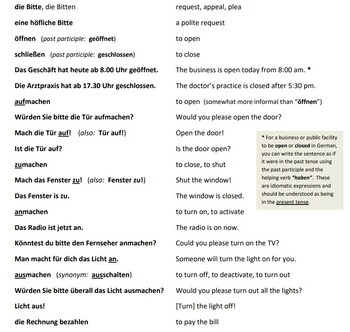
German A1 - Vocabulary Review Bundle 2
Fourteen 2-page vocabulary handouts for review and study. Includes grammar notes. Most vocabulary words are shown in one or more sample sentences. Corresponds roughly with the Schritte International A1.2 course material but can be used with just about any advanced A1 course. (An excellent companion to German A1 - Level 2 - Vocabulary Review and Grammar Notes.)
Subjects:
Grades:
8th - 12th, Higher Education, Adult Education, Staff
Types:

German A2 - Subjunctive Mood - Using 'würden', 'wären' & 'hätten'
At the A1 level, students first learn to use the subjunctive mood (Konjunktiv II) for making polite requests. In this handout, students will learn how to use the subjunctive to describe improbable situations and make hypothetical statements. This lesson focuses on the verbs 'würden', 'wären' and 'hätten'. Copious example sentences are provided with parallel English translations. The English subjunctive is described in detail alongside the German subjunctive, illustrating the structural diffe
Subjects:
Grades:
9th - 12th, Higher Education, Adult Education, Staff
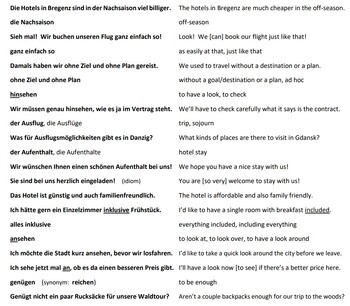
German A2 - Vocabulary Review Bundle 2
20 vocabulary handouts for review and study. Each handout contains 2-3 pages of new vocabulary, sample sentences and grammar notes. Corresponds roughly with the Schritte International A2.2 course material but can be used with just about any advanced-level A2 course in preparation for B1.
Subjects:
Grades:
10th - 12th, Higher Education, Adult Education, Staff
Types:
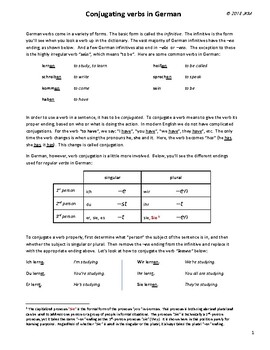
German A1 - Conjugating Verbs
Seven verbs are chosen here as a starting point: lernen, kommen, schreiben, heißen, haben, sprechen & sein. Here, the student learns the regular verb endings and how these are applied based on 'person' and 'number'. Various irregularities are looked at as well. Conjugations for each verb are first broken down in chart form, and afterwards the student can see the verbs being used in sample sentences. Word order when forming questions is also covered.
Subjects:
Grades:
9th - 12th, Higher Education, Adult Education, Staff
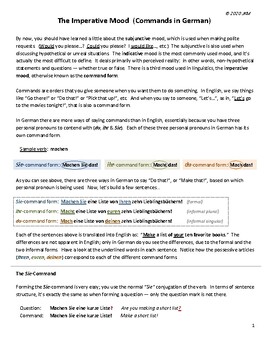
German A1 - The Imperative Mood (Commands in German)
This thorough 8-page lesson on the imperative mood (commands) is broken into sections so that both teacher and student can focus on different aspects of the imperative. Separate sections are dedicated to Sie-commands and ihr-commands, while the rules for du-commands are explained in detail over the course of several pages. Some example sentences are color coded for clarity. (The du-command rules are illustrated using large fonts and graphics.)Students new to the imperative mood can concentrat
Subjects:
Grades:
9th - 12th, Higher Education, Adult Education, Staff
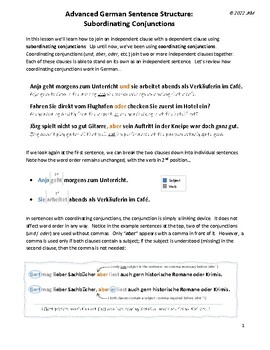
German A2 - Advanced Sentence Structure (Subordinating Conjunctions)
This is a thorough primer on subordinating conjunctions and the placement of verbs in dependent (subordinate) clauses in German. The lesson starts out with a review of coordinating conjunctions and then compares how they're used vs. subordinating conjunctions by comparing 'denn' with 'weil'. Other conjunctions covered are: wenn, ob, als, da and obwohl. The subtle differences between some of these conjunctions are discussed, as well as how they should be translated into English, and vice-vers
Subjects:
Grades:
10th - 12th, Higher Education, Adult Education, Staff
Types:
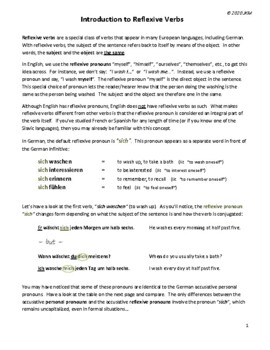
German A2 - Introduction to Reflexive Verbs
Reflexive verbs are special verbs used in situations where the subject and the object are one in the same. Reflexive verbs are used frequently in German, often on occasions where the reflexive wouldn't normally be used in English. This handout dissects the basic elements of the reflexive verb and explains how it's used. The differences between reflexive pronouns and accusative personal pronouns are illustrated. (Dative reflexive pronouns are discussed in a different handout.)Six verbs are ch
Subjects:
Grades:
9th - 12th, Higher Education, Adult Education, Staff
Types:
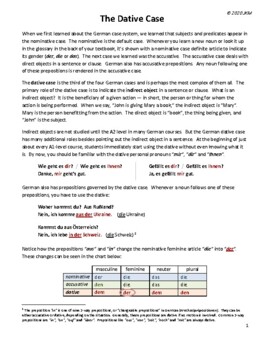
German A1 - The Dative Case
Most students encounter the dative case just a couple weeks or so into their first German course, not yet knowing what it is or how it functions. In the beginning, we take it almost for granted that "Wie geht es dir?" means "How are you doing?" We also learn to say things like "Ich komme aus den Niederlanden", or "Wir leben in der Schweiz" — without fully learning the underlying grammar.In this advanced A1-level handout, students will get their first nuts & bolts view of how this versatile
Subjects:
Grades:
10th - 12th, Higher Education, Adult Education, Staff
Types:
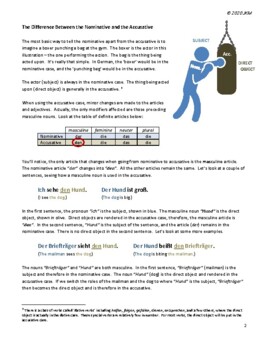
German A1 - Introduction to the Accusative Case
This 7-page handout covers the basics of the German accusative case, beginning with all the articles and their declensions. (The first page describes what a case system is and provides a brief overview of each of the German cases: nominative, accusative, dative & genitive.) Color-coded sample sentences illustrate the function of nouns in the sentence and how to differentiate between the nominative and the accusative. Accusative prepositions are covered next. Sample sentences containing
Subjects:
Grades:
9th - 12th, Higher Education, Adult Education, Staff
Types:
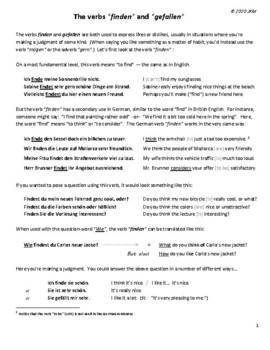
German A1 - Expressing Opinions using 'finden' & 'gefallen'
This 5-page lesson provides detailed information on how to express opinions using the verbs 'finden' and 'gefallen'. Color-coded example sentences explain the underlying grammatical differences between these two verbs. Students will learn to how to use them to make statements, to ask yes-no questions and questions with "wie".
Subjects:
Grades:
9th - 12th, Higher Education, Adult Education, Staff
Showing 1-24 of 98 results





